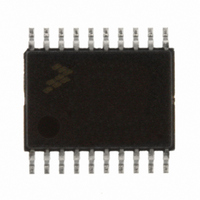MC9S08EL16CTJ Freescale Semiconductor, MC9S08EL16CTJ Datasheet - Page 179

MC9S08EL16CTJ
Manufacturer Part Number
MC9S08EL16CTJ
Description
MCU 16KB FLASH SLIC 20TSSOP
Manufacturer
Freescale Semiconductor
Series
HCS08r
Datasheet
1.DEMO9S08EL32.pdf
(356 pages)
Specifications of MC9S08EL16CTJ
Core Processor
HCS08
Core Size
8-Bit
Speed
40MHz
Connectivity
I²C, LIN, SCI, SPI
Peripherals
LVD, POR, PWM, WDT
Number Of I /o
16
Program Memory Size
16KB (16K x 8)
Program Memory Type
FLASH
Eeprom Size
512 x 8
Ram Size
1K x 8
Voltage - Supply (vcc/vdd)
2.7 V ~ 5.5 V
Data Converters
A/D 12x10b
Oscillator Type
External
Operating Temperature
-40°C ~ 85°C
Package / Case
20-TSSOP
Processor Series
S08EL
Core
HCS08
Data Bus Width
8 bit
Data Ram Size
1 KB
Interface Type
SCI, SPI, I2C, SLIC
Maximum Clock Frequency
200 KHz
Number Of Programmable I/os
16
Number Of Timers
2
Operating Supply Voltage
5.5 V
Maximum Operating Temperature
+ 85 C
Mounting Style
SMD/SMT
3rd Party Development Tools
EWS08
Development Tools By Supplier
DEMO9S08EL32AUTO, DEMO9S08EL32
Minimum Operating Temperature
- 40 C
On-chip Adc
10 bit, 12 Channel
For Use With
DEMO9S08EL32 - BOARD DEMO FOR 9S08 EL MCUDEMO9S08EL32AUTO - DEMO BOARD EL32 AUTO
Lead Free Status / RoHS Status
Lead free / RoHS Compliant
- Current page: 179 of 356
- Download datasheet (9Mb)
After a repeated start condition (Sr), all other slave devices also compare the first seven bits of the first
byte of the slave address with their own addresses and test the eighth (R/W) bit. However, none of them
are addressed because R/W = 1 (for 10-bit devices) or the 11110XX slave address (for 7-bit devices) does
not match.
After the master-receiver has sent the first byte of the 10-bit address, the slave-transmitter sees an IIC
interrupt. Software must ensure the contents of IICD are ignored and not treated as valid data for this
interrupt.
11.4.3
General calls can be requested in 7-bit address or 10-bit address. If the GCAEN bit is set, the IIC matches
the general call address as well as its own slave address. When the IIC responds to a general call, it acts as
a slave-receiver and the IAAS bit is set after the address cycle. Software must read the IICD register after
the first byte transfer to determine whether the address matches is its own slave address or a general call.
If the value is 00, the match is a general call. If the GCAEN bit is clear, the IIC ignores any data supplied
from a general call address by not issuing an acknowledgement.
11.5
The IIC is disabled after reset. The IIC cannot cause an MCU reset.
11.6
The IIC generates a single interrupt.
An interrupt from the IIC is generated when any of the events in
is set. The interrupt is driven by bit IICIF (of the IIC status register) and masked with bit IICIE (of the IIC
control register). The IICIF bit must be cleared by software by writing a 1 to it in the interrupt routine. You
can determine the interrupt type by reading the status register.
11.6.1
The TCF (transfer complete flag) bit is set at the falling edge of the ninth clock to indicate the completion
of byte transfer.
Freescale Semiconductor
S
11110 + AD10 + AD9
Slave Address
1st 7 bits
Resets
Interrupts
General Call Address
Byte Transfer Interrupt
Table 11-11. Master-Receiver Addresses a Slave-Transmitter with a 10-bit Address
Match of received calling address
R/W
0
MC9S08EL32 Series and MC9S08SL16 Series Data Sheet, Rev. 3
Complete 1-byte transfer
A1
Interrupt Source
Arbitration Lost
Slave Address
2nd byte
AD[8:1]
Table 11-12. Interrupt Summary
A2
Sr
11110 + AD10 + AD9
Slave Address
Status
ARBL
IAAS
TCF
1st 7 bits
Table 11-12
IICIF
IICIF
IICIF
Flag
R/W
1
Local Enable
A3
occur, provided the IICIE bit
Inter-Integrated Circuit (S08IICV2)
IICIE
IICIE
IICIE
Data
A
...
Data
A
179
P
Related parts for MC9S08EL16CTJ
Image
Part Number
Description
Manufacturer
Datasheet
Request
R
Part Number:
Description:
Manufacturer:
Freescale Semiconductor, Inc
Datasheet:
Part Number:
Description:
Manufacturer:
Freescale Semiconductor, Inc
Datasheet:
Part Number:
Description:
Manufacturer:
Freescale Semiconductor, Inc
Datasheet:
Part Number:
Description:
Manufacturer:
Freescale Semiconductor, Inc
Datasheet:
Part Number:
Description:
Manufacturer:
Freescale Semiconductor, Inc
Datasheet:
Part Number:
Description:
Manufacturer:
Freescale Semiconductor, Inc
Datasheet:
Part Number:
Description:
Manufacturer:
Freescale Semiconductor, Inc
Datasheet:
Part Number:
Description:
Manufacturer:
Freescale Semiconductor, Inc
Datasheet:
Part Number:
Description:
Manufacturer:
Freescale Semiconductor, Inc
Datasheet:
Part Number:
Description:
Manufacturer:
Freescale Semiconductor, Inc
Datasheet:
Part Number:
Description:
Manufacturer:
Freescale Semiconductor, Inc
Datasheet:
Part Number:
Description:
Manufacturer:
Freescale Semiconductor, Inc
Datasheet:
Part Number:
Description:
Manufacturer:
Freescale Semiconductor, Inc
Datasheet:
Part Number:
Description:
Manufacturer:
Freescale Semiconductor, Inc
Datasheet:
Part Number:
Description:
Manufacturer:
Freescale Semiconductor, Inc
Datasheet:










